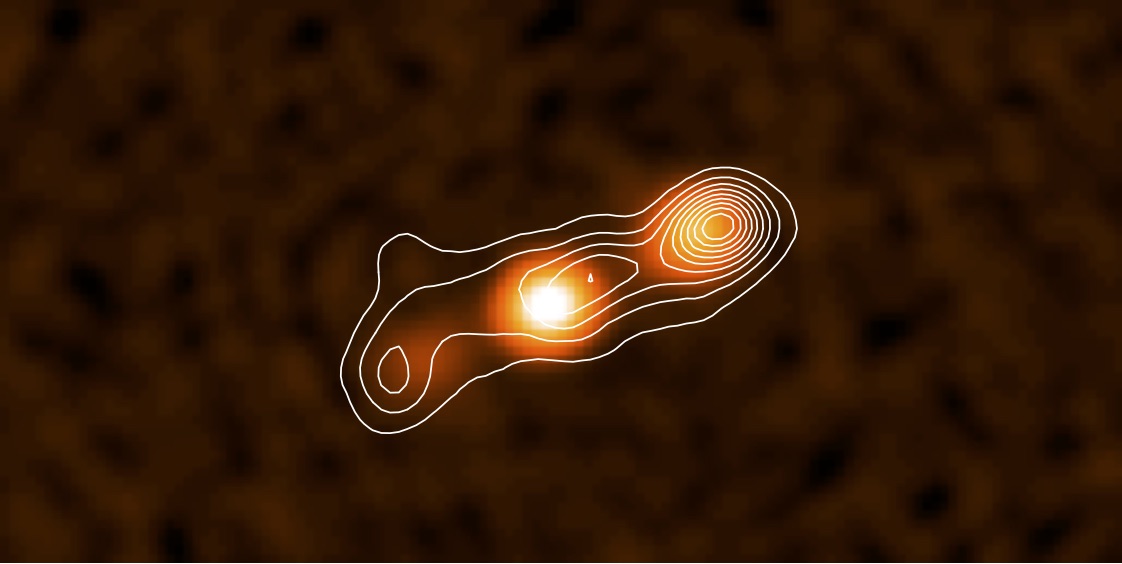Daily Image
22-11-2016Radio jets in IC 5063 are observed to drive a warm and dense molecular outflow
| Submitter: | K. M. Dasyra, F. Combes, T. Oosterloo, J. B. R. Oonk, R. Morganti, P. Salome', and N. Vlahakis |
| Description: | The enigmatic nearby Seyfert galaxy IC 5063 was the first galaxy known (Morganti+ 1998) to harbour a fast outflow of atomic hydrogen driven by the radio jets and later observations showed that also optical and near-infrared line emitting gas participates in this outflow. The molecular counterpart, observed in the CO J=2-1 line, of this outflow was first detected by Astron astronomers Raffaella Morganti, Tom Oosterloo and Raymond Oonk with APEX and subsequently mapped by them in detail with ALMA. However, with only one CO transition it is not possible to say anything reliably about the conditions (and hence the mass involved) of this molecular gas and therefore more observations were done with ALMA. The new ALMA CO J=4-3 observations, in a study led by Kalliopi Dasyra (National and Kapodistrian University of Athens) and including Morganti, Oosterloo and Oonk, show that the CO J=4-3 emission from the regions affected by the radio jet is much brighter than the CO J=2-1 emission. Combining these results with the previous CO J=2-1 information, a much better estimate of the mass of the outflowing molecular gas can be made. The data show that the outflowing molecular gas in IC 5063 is warm and dense, and also that it is optically thin. This implies that the mass of the outflowing molecular gas may be even an order of magnitude lower than previously estimated. Earlier estimates indicated that, by far, most of the gas in the outflow is molecular, but the new result suggests that there is roughly a 50-50 balance between molecular and atomic hydrogen. The minimum outflowing mass indicated by the new observations is 2*10^6 solar masses. The regions unaffected by the jet, in the larger-scale gas disk, show normal levels of the CO J=4-3 to J=2-1 emission, thus indicating the existence of regular cold, quiescent molecular gas here. This investigation shows that radio loud AGN do not only expel cold gas, but also heat this gas, thereby preventing it from partaking in star formation. Knowledge of the total outflowing mass, and other properties of the gas, is very important for our understanding of the role that AGN and their radio jets play in the evolution of galaxies. The very bright emission observed in IC 5063 for the higher CO transition is also interesting for future studies of higher redshift sources, as it shows that these important transitions may be more easily detected than previously expected. The image shows the radio emission, as observed with ALMA, of the radio jet and its hot spots, while the contours show the bright CO emission, nicely wrapping around the radio jet, indicating a close connection between the two. The spatial resolution of this image is about 0.5 arcsec. An animation illustrating the results in IC 5063 can be found here https://www.youtube.com/watch?v=sopEHuZeOgY. In this animation, the jet is shown as a red beam propagating through the galaxy. The white, dense clouds form the disk of the galaxy. The results are based on observations collected with the Atacama Large Millimeter Array (ALMA) and are now published in A&A (Dasyra et al.). They can also be found here: https://arxiv.org/abs/1609.03421 |
| Copyright: | Dasyra et al/Astron |
| Tweet |  |
